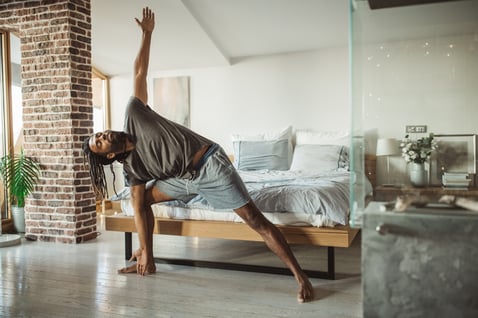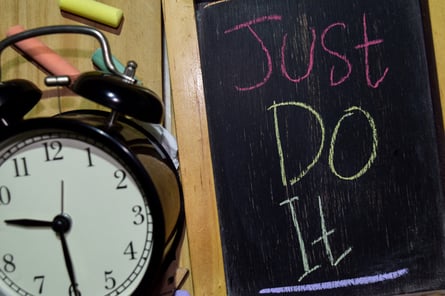The holidays are a challenging time because there are so many more delicious foods everywhere. For some people, this is a time of year when they consume more alcohol. Unfortunately, most of these cocktails are loaded with calories. Here are some tips that can help keep the celebration—but not increase your waistline!
- Choose cocktails that don’t add a lot of calories beyond the alcohol with high-calorie mixers. Order soda water and a splash of cranberry juice or diet soda as the mixer.
- Have a non-caloric beverage (such as water, iced tea, or decaf coffee) in between alcoholic drinks.
- Order your drink with extra ice.
- Set a goal to stick to the alcohol recommendations for adults: 1 drink per day for women and 2 drinks per day for men. A drink is 5 ounces of wine, 1½ ounces of liquor, or 12 ounces of beer.
Try some of these lower-calorie beverages instead!
Made-over Eggnog 
Ingredients:
- 3 large eggs
- 3 large egg whites
- 5½ cups low-fat or skim milk
- ¼ cup sugar
- ¼ cup Splenda or alternative sweetener
- 2 TB. cornstarch
- Pinch of salt
- 2 TB. vanilla
- ½ tsp. (plus additional for sprinkling) ground nutmeg
- ⅓ cup dark rum (optional)
Directions:
-
In a bowl, with a whisk, beat eggs and egg whites until blended; set aside.
-
In a heavy 4-quart saucepan, with heat-safe spatula, mix 4 cups milk with sugar, cornstarch, and ¼ teaspoon salt.
-
Cook on medium-high until mixture boils and thickens slightly, stirring constantly. Boil 1 minute. Remove saucepan from heat.
-
Gradually whisk ½ cup simmering milk mixture into eggs; pour egg mixture back into milk in saucepan, whisking constantly, to make custard.
-
Pour custard into large bowl; stir in vanilla, nutmeg, rum (if using), and remaining 1½ cups milk.
-
Cover and refrigerate until well chilled, at least 6 hours or up to 2 days.
-
Sprinkle eggnog with nutmeg to serve. Makes about 6½ cups.
Serves: 13 Serving size: 1 cup
Calories: 90 Fat: 2g Carbohydrates: 10g Protein: 6g
Sparkling Pomegranate Cocktail
Ingredients:
- 1½ cups pomegranate juice
- ¼ cup grenadine
- 1 (750-milliliter) bottle Prosecco or dry sparkling wine, chilled
- 6 lime slices (optional)
- Pomegranate seeds (optional)
Directions:
- Combine pomegranate juice and ¼ cup grenadine in a 2-cup glass measure.
- Divide the juice mixture evenly among 6 Champagne flutes or wine glasses. Top each serving evenly with wine, and garnish each serving with lime slices and seeds, if desired.
Serves: 6 Serving size: ¾ cup
Calories: 164 Fat: 0 Carbohydrates: 21g Protein: 0g
Spiced Hot Cider
Ingredients:
- 4 cups apple cider
- 1 cinnamon stick
- 5 whole cloves
- ½ cup applejack (apple brandy)
- 2 TB. cinnamon schnapps
- Cinnamon sticks, for garnish
Directions:
- Bring apple cider, cinnamon stick, and cloves to a boil.
- Reduce heat and simmer for 5 minutes. Add applejack and schnapps. Garnish with a cinnamon stick and serve hot.
Serves: 6 Serving size: ¾ cup
Calories: 143 Fat: 0g Carbohydrates: 23g Protein: 0g


 These past few weeks have been trying times for not only our families and friends, but also for the athletes we engage with on a daily basis throughout the year. In our position we must stay in a lead-by-example mentality. If we let ourselves go during this time, our athletes will notice and do the exact same thing. This is definitely a time of uncertainty and there are a lot of unknowns. Controlling what we can control on a daily basis is what will help not just us personally, but also those around us, to get through and come out of this on top.
These past few weeks have been trying times for not only our families and friends, but also for the athletes we engage with on a daily basis throughout the year. In our position we must stay in a lead-by-example mentality. If we let ourselves go during this time, our athletes will notice and do the exact same thing. This is definitely a time of uncertainty and there are a lot of unknowns. Controlling what we can control on a daily basis is what will help not just us personally, but also those around us, to get through and come out of this on top. Personal trainers are people, too (well, at least when no one is looking!). In reality, there are a lot of new bridges we, as a society, are crossing every single day. As a trainer, my goal is to put all my effort into making sure that my clients are being healthy with fitness and wellness as a priority. With the lockdown upon us, finding new ways to get this job done is a challenge, but so is making sure that you are finding time for yourself.
Personal trainers are people, too (well, at least when no one is looking!). In reality, there are a lot of new bridges we, as a society, are crossing every single day. As a trainer, my goal is to put all my effort into making sure that my clients are being healthy with fitness and wellness as a priority. With the lockdown upon us, finding new ways to get this job done is a challenge, but so is making sure that you are finding time for yourself.  There are no definitive right answers on how we are supposed to individually succeed during a pandemic. We all cope, struggle, and win the day in our own ways. We can all feel a little lost and confused at times, and that’s completely normal as we cross bridges into territory we have never experienced in our lives.
There are no definitive right answers on how we are supposed to individually succeed during a pandemic. We all cope, struggle, and win the day in our own ways. We can all feel a little lost and confused at times, and that’s completely normal as we cross bridges into territory we have never experienced in our lives. .jpg?width=404&name=GettyImages-980276548(1).jpg)
 Ingredients
Ingredients The temperatures are still frigid, and there are days when it seems as if the sun doesn’t shine. This is the time of year when we can start to feel down and less motivated, and maybe start to develop a case of the winter blues. It's easy for these negative thoughts to start creeping into our heads, but it is just as easy to kick these thoughts to the curb with these five simple steps.
The temperatures are still frigid, and there are days when it seems as if the sun doesn’t shine. This is the time of year when we can start to feel down and less motivated, and maybe start to develop a case of the winter blues. It's easy for these negative thoughts to start creeping into our heads, but it is just as easy to kick these thoughts to the curb with these five simple steps. How many of us are guilty of making a New Year’s resolution and then struggling to stick to it by the time February rolls around? Even with the best of intentions, most of us have trouble maintaining the changes that start off so strong on January 1st. Often these promises to ourselves are centered around our overall health and well-being.
How many of us are guilty of making a New Year’s resolution and then struggling to stick to it by the time February rolls around? Even with the best of intentions, most of us have trouble maintaining the changes that start off so strong on January 1st. Often these promises to ourselves are centered around our overall health and well-being. If you’re trying to lose weight, you’ve probably started exercising, maybe you’re trying a new diet, and maybe you’ve been super consistent for months now, but nothing’s changing. You feel like you’re doing everything right, but you haven’t seen any changes on the scale. How can this be? Weight loss is all about diet and exercise, so why aren’t the pounds just falling off? Research suggests there’s more to weight loss and weight management than diet and exercise alone.
If you’re trying to lose weight, you’ve probably started exercising, maybe you’re trying a new diet, and maybe you’ve been super consistent for months now, but nothing’s changing. You feel like you’re doing everything right, but you haven’t seen any changes on the scale. How can this be? Weight loss is all about diet and exercise, so why aren’t the pounds just falling off? Research suggests there’s more to weight loss and weight management than diet and exercise alone. We’ve all been there, right? You’ve chosen a new habit that you want to form: go to the gym four times a week, choose one day a week to grocery shop and meal prep, maybe start work on that side hustle you’ve been meaning to do for years. You’re all in, gung-ho for about five days, and before you know it, you’ve fallen back into the same routine as before. That bright flame that once was your motivation has faded into the background. Now what?
We’ve all been there, right? You’ve chosen a new habit that you want to form: go to the gym four times a week, choose one day a week to grocery shop and meal prep, maybe start work on that side hustle you’ve been meaning to do for years. You’re all in, gung-ho for about five days, and before you know it, you’ve fallen back into the same routine as before. That bright flame that once was your motivation has faded into the background. Now what? It’s the end of the day. There was a string of meetings to attend, a pile of emails to answer, an argumentative colleague to work with, maybe even kids yelling for pizza when you had chicken planned for dinner instead. By the time you get home, you’ve already made a plethora of decisions, from how to approach a problem at work to what shoes to wear on your way out the door. You told yourself you would exercise when you got home, but now the couch looks a lot more enticing. All those decisions you made have taken a biological toll on your motivation and self-control, whether you realize it or not.
It’s the end of the day. There was a string of meetings to attend, a pile of emails to answer, an argumentative colleague to work with, maybe even kids yelling for pizza when you had chicken planned for dinner instead. By the time you get home, you’ve already made a plethora of decisions, from how to approach a problem at work to what shoes to wear on your way out the door. You told yourself you would exercise when you got home, but now the couch looks a lot more enticing. All those decisions you made have taken a biological toll on your motivation and self-control, whether you realize it or not.